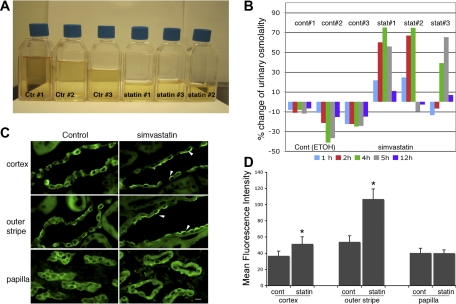Fig. 5.
Simvastatin increases urinary concentration and induces membrane accumulation of AQP2 in the CD of kidneys from Brattleboro (BB) rats. After treatment, the urine output from each animal (3 animals in the control group and 3 animals in the treated group) was collected and measured every hour during the first 6 h and then every 12 h after injection. The total urine volume of pooled 6-h urine from individual animals was measured and photographed (A). Clearly, the simvastatin-treated group produces less than half of the urine volume compared with the control animals. An increase in urinary osmolality is detectable as soon as 1 h after injection (B). The percentage increase or decrease of hourly urinary osmolality in individual animals compared with its own baseline after injection is shown in B. There is a clear stimulatory effect on urinary osmolality in treated animals (statin#) compared with the controls (cont#) within 6 h postinjection. AQP2 distribution in CD of treated and control BB animals was examined by immunofluorescence staining of kidneys (C). In rats treated with simvastatin for 6 h, there is a significant membrane accumulation of AQP2 in CD principal cells in the cortex and medullary outer stripe but not in the papilla. The fluorescence signal resulting from apical AQP2 in principal cells was acquired and quantified using IPlab software as detailed in the text (D). There is a significant increase of apical AQP2 staining in CD from cortex and outer medulla in treated animals. Error bars represent means ± SE. *P < 0.01. Scale bar = 10 μm in C. Arrows indicate membrane accumulation of AQP2.

